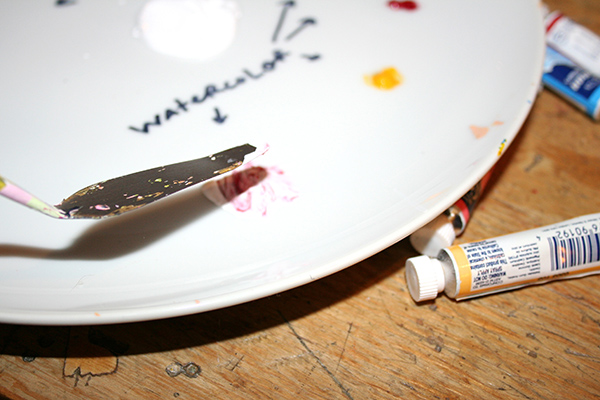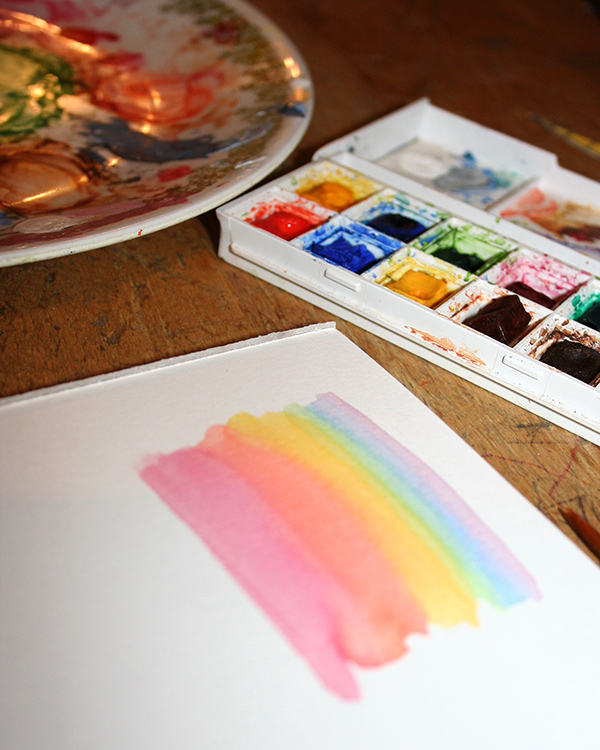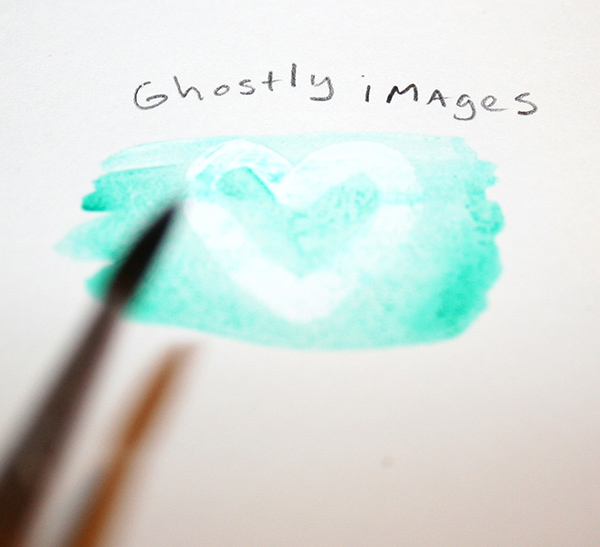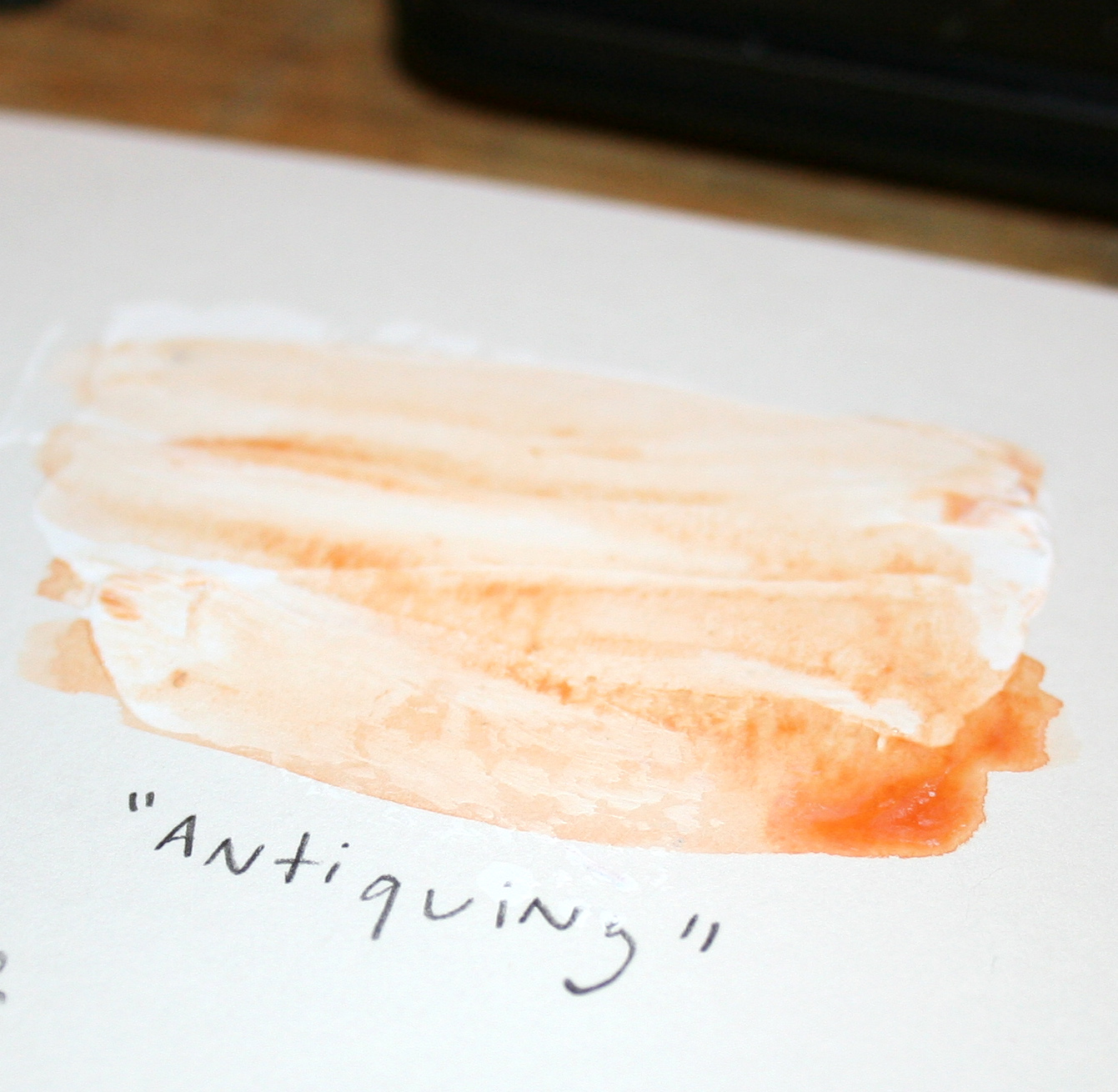Acrylic and watercolor might seem as if they orbit in different artistic solar systems. Each is suited to very different styles of painting.

Acrylic is a medium that dries with a flat, opaque, almost plastic-like consistency, whereas watercolor is fluid and creates natural tonal variations based on the amount of water added. But magic can happen when you combine these very different types of paint.
Ready to be inspired? Here are just a few ways you can combine acrylic and watercolor to create luminous works of art.
Mixing acrylic with watercolor

By mixing acrylic with watercolor, you can create paint with very unique qualities of color and opacity, that can be adjusted based on the ratio of the paint types and water. All you have to do is set up a palette with several colors of watercolor, and using a palette knife, mix them with a dab of acrylic.
Create stunning, vibrant colors!
<!–Mix the colors you’re dreaming of using just a handful of paints.Enroll Now »

Adjust the ratio of watercolor to acrylic until you’ve reached a color that pleases you. Depending on the ratio of colors, you can achieve different textures and finishes with your paint. For example:
- A lot of watercolor with just a touch of acrylic will give you a sort of “fortified watercolor” look–more solid and opaque than regular watercolor, but maintaining the natural variations of color and tone as it is painted across the paper.
- More acrylic with a touch of watercolor is more subtle, but you will attain more delicate tones than you would with just straight-out acrylic. It’s almost like you make a more “painterly” acrylic.

You can experiment even more with mixing acrylic and watercolor, testing how it might look to paint with a semi-mixed color combination, or testing the outcome when you dilute the paint with more or less water.
Notes:
- While white acrylic will work with any color, you can also use a colored acrylic paint for unique results.
- Once dry, consider this paint permanent–unlike watercolor, you won’t be able to revive it on your palette by adding more water, so be sure to mix enough of each color.
Watercolor background, acrylic foreground

Watercolor and acrylic can be used in tandem to create dimensional works of art. You can create a fluid, colorful background in watercolor, and then use opaque acrylic to paint forms that pop on top of the watercolor. From simple icons such as a heart painted in white acrylic atop a watercolor rainbow (pictured below), to more complicated scenes with characters painted in acrylic over a beautiful backdrop, this is an easy way to get a less “flat” effect by combining media.

Acrylic on top of wet watercolor

By painting with acrylic on top of still-wet watercolor, you can attain some very pretty, sheer-looking results. For instance, on the above image, white acrylic paint is applied over a still-wet wash of blue watercolor paint. Because the watercolor is still quite wet, the color is gently combined with the white acrylic paint, giving it a semi-transparent look, less flat than simply painting white clouds atop a dried watercolor surface, which would dry opaque.
Watercolor on top of dried or mostly dried acrylic
There are several ways to use watercolor on top of dried acrylic.
Ghostly images

You can create ghostly images by painting watercolor over dried acrylic. For instance, in the above image, a heart was first painted in white acrylic on a sheet of Bristol board. It doesn’t look like much, until a watercolor wash is applied over the acrylic. If the acrylic is completely dried, it will show through the watercolor unevenly, giving you a mysterious-looking image; if the acrylic is still slightly wet, the watercolor will give it a ghostly fuzz around the edges. Either way, this effect can be put to good use when creating subtle imagery.
Antique look

If you paint a larger area with acrylic paint, you can create a sort of antique look by painting over it with watercolor paint. This method is especially helpful when creating architectural elements in a painting, but can be used whenever you want to give an object a patina-style finish. While white is used in the above example, you can employ any sort of color combination–for instance, it might be well suited to creating an area of mint green acrylic and covering it with copper watercolor, or vice versa, to create an image such as the Statue of Liberty.
Correcting mistakes
It bears mention: acrylic can also be employed to fix mistakes in watercolor paintings. Its opacity can be applied to cover up errant paint marks quite easily.
Have you ever combined acrylic and watercolor in a painting?
<!–Create stunning, vibrant colors!
Mix the colors you’re dreaming of using just a handful of paints.Enroll Now »

I painted green leaves on top of a brown door. The leaves are not showing up well so I was thinking that I could try acrylics and go over the leaves.
Love this info ThankU 💜
want to learns to mix paint for dolls making
Liked the beginning
Thank you for the info. I just started watercolor painting and I don't have e many colors yet. I have some acrylic paints too and was just wondering about using both in a painting I'm working on.
How do you frame a watercolor and acrylic painting? Glass or no glass?
I've not done this, but I'm excited to try and see what happens. Will definitely be trying all of these different methods in a sketchbook soon! What a cool idea.
I have been really comfortable with watercolor, and I am rather intimidated by acrylic because it is not as forgiving as watercolor. Everything I have seen says acrylic over watercolor, period. I am so excited to find I can mix acrylic and watercolor without a medium like gesso. I can't wait to start experimenting! I have a pad of multimedia paper that I think will finally be of some use without worrying about overworking the paper. :-)
I love that idea watercolourviver acrylic paint
If you put let’s say orange water color over a black/grey opaque acrylic painting will it look like you painted the shades of the orange color?